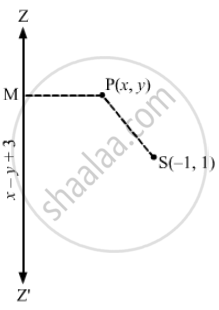Advertisements
Advertisements
प्रश्न
Find the equation for the ellipse that satisfies the given conditions:
Major axis on the x-axis and passes through the points (4, 3) and (6, 2).
उत्तर
Let the equation of ellipse be `x^2/a^2 + y^2/b^2 = 1`
It goes through the points (4, 3) and (6, 2)
`16/a^2 + 9/b^2 = 1` ...(i)
`36/a^2 + 4/b^2 = 1` ...(ii)
On multiplying equation (i) by 4 and equation (ii) by 9
`64/a^2 + 36/b^2 = 4` ...(iii)
`324/a^2 + 36/b^2` ...(iv)
By subtracting equation (iii) from equation (iv),
`260/a^2 = 5`
or `a^2 = 260/52`
Putting the value of a2 in equation (i),
`16/52 + 9/b^2 = 1`
or `9/b^2 = 1 - 16/52 = 36/52`
`9/b^2 = 36/52`
or `b^2 = (9 xx 52)/36 = 13`
∴ Equation of ellipse, `x^2/52 + y^2/13 = 1`.
APPEARS IN
संबंधित प्रश्न
Find the equation for the ellipse that satisfies the given conditions:
Vertices (0, ±13), foci (0, ±5)
Find the equation for the ellipse that satisfies the given conditions:
Ends of major axis (0, `+- sqrt5`), ends of minor axis (±1, 0)
Find the equation for the ellipse that satisfies the given conditions:
Length of major axis 26, foci (±5, 0)
Find the equation for the ellipse that satisfies the given conditions:
Length of minor axis 16, foci (0, ±6)
Find the equation for the ellipse that satisfies the given conditions:
Foci (±3, 0), a = 4
Find the equation for the ellipse that satisfies the given conditions:
b = 3, c = 4, centre at the origin; foci on the x axis.
Find the equation for the ellipse that satisfies the given conditions:
Centre at (0, 0), major axis on the y-axis and passes through the points (3, 2) and (1, 6)
A man running a racecourse notes that the sum of the distances from the two flag posts form him is always 10 m and the distance between the flag posts is 8 m. find the equation of the posts traced by the man.
Find the equation of the ellipse in the case:
focus is (−1, 1), directrix is x − y + 3 = 0 and e = \[\frac{1}{2}\]
Find the equation of the ellipse in the case:
focus is (−2, 3), directrix is 2x + 3y + 4 = 0 and e = \[\frac{4}{5}\]
Find the equation of the ellipse in the case:
focus is (1, 2), directrix is 3x + 4y − 5 = 0 and e = \[\frac{1}{2}\]

Find the equation to the ellipse (referred to its axes as the axes of x and y respectively) which passes through the point (−3, 1) and has eccentricity \[\sqrt{\frac{2}{5}}\]
Find the equation of the ellipse in the case:
eccentricity e = \[\frac{1}{2}\] and foci (± 2, 0)
Find the equation of the ellipse in the case:
eccentricity e = \[\frac{2}{3}\] and length of latus rectum = 5
Find the equation of the ellipse in the case:
eccentricity e = \[\frac{1}{2}\] and semi-major axis = 4
Find the equation of the ellipse in the case:
The ellipse passes through (1, 4) and (−6, 1).
Find the equation of the ellipse in the case:
Vertices (± 5, 0), foci (± 4, 0)
Find the equation of the ellipse in the case:
Vertices (0, ± 13), foci (0, ± 5)
Find the equation of the ellipse in the following case:
Ends of major axis (0, ±\[\sqrt{5}\] ends of minor axis (± 1, 0)
Find the equation of the ellipse in the following case:
Length of major axis 26, foci (± 5, 0)
Find the equation of the ellipse in the following case:
Length of minor axis 16 foci (0, ± 6)
A bar of given length moves with its extremities on two fixed straight lines at right angles. Any point of the bar describes an ellipse.
If P is a point on the ellipse `x^2/16 + y^2/25` = 1 whose foci are S and S′, then PS + PS′ = 8.
The line 2x + 3y = 12 touches the ellipse `x^2/9 + y^2/4` = 2 at the point (3, 2).
